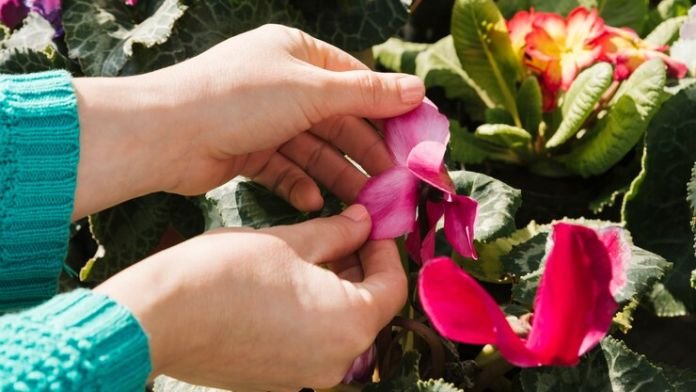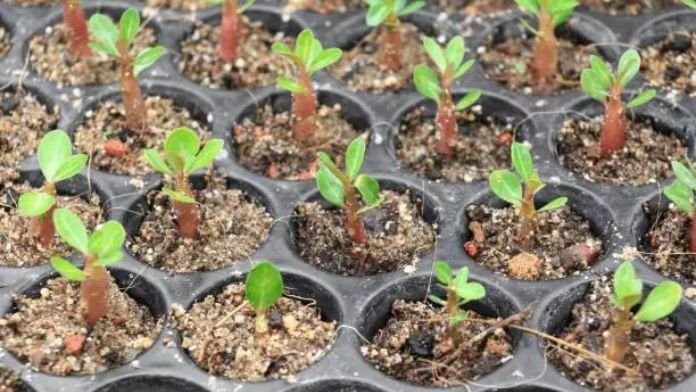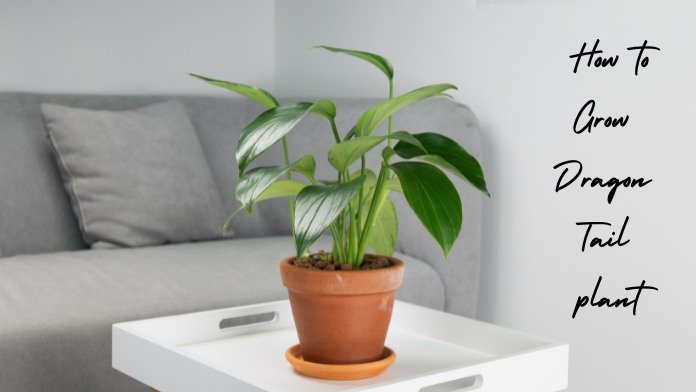
How to Grow and Care for Desert Rose Plant
Desert rose (Adenium obesum) is a slow-growing plant, grow and care for desert rose plant, growing only 12 inches per year. Desert rose is often used as a bonsai plant for its thick, succulent stems, thin, delicate leaves, and luscious deep pink trumpet flowers. The desert rose is an indoor or outdoor plant, depending on its location.
In many warm, tropical climates (USDA zones 11 and 12), it is a widely used outdoor ornamental plant, and in colder regions, it is grown indoors. It is best planted in spring and will die if exposed to frost and freezing temperatures. A member of the oleander family, the sap of the desert rose plant is toxic to humans and pets. Read on for our care guidelines.

| Common name | Desert rose, Sabi star, mock azalea, impala lily |
| Botanical name | Adenium obesum |
| Family | Apocynaceae |
| Plant type | Succulent |
| Mature size | 3–9 ft. tall, 3–5 ft. wide |
| Sun Exposure | Full |
| Soil type | Sandy, well-drained |
| Soil pH | Neutral to acidic |
| Bloom time | Summer |
| Flower color | Pink, red, rose |
| Hardiness zones | 11-12 (USDA) |
| Toxicity | Toxic to humans1 and pets |
Desert Rose Care
These are the main care requirements for growing desert roses:
- Desert roses require careful water management and plenty of sunlight.
- The plant prefers consistently warm temperatures.
- It prefers sandy soil with good drainage.
Light
Desert roses thrive in a full-sun environment. Choose a location in your home where the plant receives plenty of light throughout the day, such as a bright south-facing window or sunroom.
If you live in an area where it can be successfully grown outdoors, the best place to plant a desert rose is an area that is not shaded by tall trees but has some protection from the midday sun that can burn the flower’s leaves.
Soil
As its name suggests, the desert rose plant is naturally accustomed to dry, desert-like conditions, that is, sandy or gravelly cactus soil with good drainage. Soil pH should be neutral to acidic, ideally around 6.0.
Water
Desert rose plants have different water needs depending on the time of year and temperature. During its growing season (late spring and summer), keep the soil moist but never saturated. Check the soil periodically and let it dry completely before watering. Also, plant your desert rose in a container with plenty of drainage holes.
Desert roses can be susceptible to rotting if they get too wet (a clay or terra cotta pot can also help drain excess moisture).
during the autumn and winter months (when the plant is normally dormant in the wild); Drastically reduce humidity, watering once a month or more.
If you’re wondering if your plant is getting enough water during its growing season, you can look at its stem to get the answer. A swollen and thick trunk (in proportion to the plant’s size) is a great indicator that the plant is well-hydrated.
Read more about Eucalyptus Plant Care
Temperature and Humidity
Always keep your plant at a warm temperature; It will die quickly if exposed to prolonged temperatures below 50 degrees Fahrenheit. It thrives best in temperatures between 65 and 90 degrees Fahrenheit. If you plant your desert rose outside, it probably won’t survive prolonged frosts. Humidity is not important for the desert rose because it is accustomed to a dry, hot climate.
Fertilizer
For an extra dose of nutrients (and potentially more blooms), you can feed your desert rose with a liquid fertilizer (half diluted) once a month during its active growth period. Do not fertilize during the plant’s dormant period.
Pruning
Before pruning your desert rose plant, use isopropyl alcohol or a bleach solution to disinfect your pruning tools; Sterilize it again as you move from one plant to another.
Remove cold-damaged growth along with new growth. Prune tall, thorny stems to balance stem growth symmetrically. Cut off branches that rub or cross other branches, just above a leaf node, or where the stem meets another stem.
Propagating a Desert Rose

Desert roses can be grown from cuttings and seeds. If you grow the plant from a cutting, the subsequent plant may not have the characteristic bulbous trunk that it would have if you propagated it from seed. Here’s how to propagate from a stem cutting:
- Before you begin, have these items handy: gardening gloves, sterile pruners, rooting hormone, a clean container, and well-draining potting mix.
- Wear gardening gloves to prevent this plant’s toxic sap from touching your skin. Using pruning shears, cut 5 to 6 inches from the tip of a branch.
- Allow the cut to dry for a day or two.
- Moisten the cut end and dip it in the rooting hormone.
- Plant the cut end in a well-drained growing medium mixed with perlite or sand soil.
- Cut water daily; However, make sure that water drains from the soil. Cuttings should take root in about two to six weeks.
- After six weeks, you should notice a new growth or, if you try to gently pull the stem, feel it root in place.
How to Grow Desert Roses from Seed

The best time to sow desert rose seeds is in spring.
- Get a well-draining potting mix with perlite or use a mix of sand and soil. You can soak the seeds for a few hours or a day beforehand to rehydrate them.
- Place one seed every 2 inches in the growing medium. Cover lightly with a thin layer of soil mixture.
- Water thoroughly and keep the plants in a warm place. Water only when the soil is dry. You can also mist the soil or water the pot from below but don’t allow the soil to become waterlogged.
- Once the seedlings have germinated, which is usually between a week and 10 days, move the pot to a sunny location.
Potting and Repotting a Desert Rose

Repot the plant as needed, usually when the roots fill the container and the plant is root-bound. It can be once a year or every two years. If you don’t want your plant to grow too big, you can keep it in its current container. Keeping a plant’s roots slows its growth. The best time to repot is in late winter or early spring, especially with new growth.
When repotting a succulent, make sure the soil is completely dry before carefully removing the plant from the pot. Remove old soil from the roots and remove any rotten or dead roots in the process. If you get a cut or wound, you can apply a fungicide or antibacterial solution topically.
Place the plant in its new pot and fill it with potting mix, spreading out the roots as you report. Allow the plant to dry for about a week to reduce the shock to the victim. After a week, water the plant but make sure the water drains well. Do not allow the plant to sit in standing water or wet soil.
How to Grow Desert Roses
The desert rose plant is the only adenium that has been extensively hybridized to obtain different flower colors.
Bloom Months
Desert roses bloom seven to eight months after planting, depending on growing conditions. The plant usually flowers in the summer months.
What Do Desert Rose Flowers Look Like?
Desert roses bloom with vibrant roses, pink or red flowers, and bright green leaves. When it is dormant in winter, it sheds its flowers and leaves.
How to Get Desert Rose to Bloom
To encourage flowering, make sure your plant gets at least six hours of sunlight and fertilize at least once a month in spring and summer. If your plant has recently been restored, it may be spending its energy growing new roots instead of flowering. Give him time to adjust to his new growing environment.
Common Problems With Desert Rose
Desert roses are relatively disease and pest-free plants. The biggest problem that affects this plant is overwatering. When growing conditions are not ideal for a plant, its natural defenses are reduced and pests or diseases appear.
Yellowing Leaves or Leaf Drop
A common symptom of root rot is yellowing or sudden wilting of leaves. A fungus causes root rot. If caught early, you may be able to save the tree. You need to remove damaged leaves and stems and loosen the root ball. If you notice black and soft roots, cut off the affected roots with a sharp knife. Between cuts, sterilize the knife. Apply a fungicide according to package directions. Transplant the remaining roots into a well-drained potting mix.
Spotting on Leaves
Powdery mildew causes blister-like spots on leaf surfaces. It can cause stunted growth and a white, powdery substance on leaves, stems, and buds. It often spreads during cool, humid nights and warm days. Powdery mildew does not like water. Spray the plant’s foliage according to package directions and apply a fungicide. Prune stems and branches when they become crowded.
The speckling of Lower Leaves
Spider mites are the most common pests that attack desert rose plants. They feed mainly by sucking sap from the underside of leaves. Leaf discoloration causes complete discoloration and eventually death of the leaf. To identify mites, blot infected leaves on a piece of white paper; Mites look like small dots. You will also notice fine webbing and eggs on the underside of the leaves. To get rid of a small infestation, forcefully spray water on the underside of all leaves. Repeat this every few days. You can also use insecticidal soap or neem oil to control mites. Be sure to apply it to the underside of the leaves and all lower surfaces of the plant.
Conclusion
Desert roses do not tolerate frost or prolonged cold. Upon reaching 50 degrees Fahrenheit, the plant will shed its leaves and initiate a gradual hibernation period. Bring your plant inside, stop watering it, and store it somewhere it won’t freeze, like a heated garage or basement, if you want to keep it alive. It will not need care or light until spring. After warmer temperatures return, water slowly, place in a window with sunny exposure, and gradually reintroduce your plant to life outside.
FAQ
Does Desert Rose like full sun?
Desert rose plants need at least 6 hours of bright, direct sunlight a day. Placing them directly in a south or west-facing window would be ideal, or if your space doesn’t provide enough natural light, use a grow light.
Can desert rose be an indoor plant?
The desert rose is an indoor or outdoor plant, depending on its location.
What is special about Desert Rose?
This slow-growing plant’s unique bulging stems, bright, vibrant flowers, and waxy, glossy leaves that are narrower, wider, and more rounded than arabicum leaves, make it an excellent choice for xeriscaping gardens or indoor growing. It is also used as a desert rose bonsai plant or adenium obesum bonsai plant!
RELATED POSTS
View all


